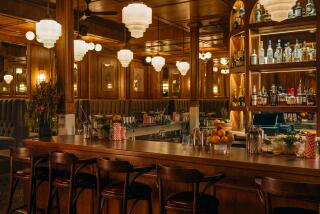Dinner theaters still offer an alternative menu
A few years back, theater manager Michael Bollinger had an open slot on his schedule and a philosophical decision to make. In the middle of the worst economy in memory, he could go with a tried and true warhorse, like a âSound of Music,â or try a musical that never even made it to Broadway.
FOR THE RECORD:
Dinner theater: An article in the Jan. 7 Calendar about dinner theaters in Southern California said Citrus College was in Glendale. The school is in Glendora. â
Bollinger isnât some Theater Row gunslinger running a storefront operation on Santa Monica Boulevard. Heâs the general manager of a conservative, risk-avoidant form of American theater â a dinner theater.
The choice for his Candlelight Pavilion stage was a surprise, even to himself. âI kept hearing from other dinner theater guys around the country â do âSmoke on the Mountain,â this one will draw for you.â Bollinger recalled. âWe started slow, but at the end of the five-week run it was selling out, and now people come up and ask when weâll bring it back.â
Even dinner theaters, it turns out, are having to take a chance these days. While 2010 saw the closure of the last existing house in once-dinner-theater-obsessed Orange County (on-stage at the time was the umpteenth revival of â Oklahoma!â), 2011 marks landmark anniversaries for two survivors on the outskirts of Southern California that have managed to survive and even thrive by turning dinner theater conventions upside down.
Hereâs a look at how the two remaining dinner theaters have managed to survive:
Candlelight Pavilion
The Candlelight Pavilion Dinner Theater, which opened in 1985 under the name Griswoldâs, is a 299-seat theater situated in a onetime converted barn in Claremont. Itâs probably one of the Southlandâs strongest theaters measured by longevity and enterprise: During 25 years, it has staged more than 170 shows. An average season sees seven or eight works for runs of between five and eight weeks, usually presenting six performances on Thursdays through Sundays. A non-Equity, for-profit house, it employs more than 100 people.
Founded by Ben Bollinger, a longtime music department chair at Citrus College in Glendale, the theater has been a family business from Day One, with nine members of the clan having worked there in some capacity over the years. Michael Bollinger, the general manager, did time at Dadâs theater on opening night as a busboy. Over the years he inter-mixed college at USC and Cal Poly Pomona with a progression of in-house jobs, from bartender to working the box office.
Why has this theater succeeded while others failed? Bollinger has strong opinions that go against conventional wisdom:
The audience: âItâs not just older people showing up in buses anymore; we draw from all age levels. For instance, a childrenâs conservancy program we have brings in a lot of family audiences.â
The shows: âThe taste in musicals has broadened out â doing standards over and over isnât what people go for now. Our most successful titles cover a range of styles â âDreamgirls,â âThe Buddy Holly Storyâ and âMenopause: The Musical.â
Dinner theaterâs appeal: âWe give people an affordable one-stop evening. Drive into L.A. for a show, thereâs gas, parking, the restaurant and then the tickets â even for a couple, that can add up to a few hundred dollars. Our price per person ranges from $48 to $70 depending on where you sit.â
Will there even be dinner theater in 10 years? âWell, weâll be here [laughs]. The economy is a big thing.... All the losses in the housing sector really hurt bad in 2008 and 2009. But people always want to have a good time, so we just have to keep figuring out how to give it to them.â?
Circle Bar B
A much smaller venue â and definitely a longer drive â awaits dinner theatergoers headed to the unlikely confines of the Circle Bar B ranch in Goleta. This compound in the foothills about 20 minutes north of Santa Barbara offers accommodations and horseback riding, but it also sports an 86-seat theater that marks its 40th season pairing tri-tip barbecue with plays (a recent title: âThe Girl in the Freudian Slipâ) when it starts in April.
Cost for dinner and show? $45.
Susie Couch has had a 17-year association with the nonprofessional, for-profit theater, first as patron, then actress and, since 2004 with her husband, David, producing the four-play season. Based on her experiences, dinner theater at this scale is viable, but keeping a close eye on the wants of the fiftysomething demographic is a must.
âWe wonât do older musicals â they cost a lot to stage and audiences now donât want the same old shows. We search out four- to 10-character comedies or smaller musicals like âPump Boys and Dinettesâ that maybe people havenât seen before. These are popular, and if they have serious themes among the laughs or are comedies that we can stage in an â80s or â90s setting, that works well for us.â
Couch, who says about 40% of the audience comes from L.A. and Orange counties, is equally attuned to contemporary marketing strategies. âWe arenât texting or twittering ⌠yet. But we do have a Facebook page as well as an online homepage that help us get to people â no more mailing fliers.
âBut hereâs the main thing: You have to be affordable, no matter what the entertainment is. People now pay attention to price first. So we do too.â
More to Read
The biggest entertainment stories
Get our big stories about Hollywood, film, television, music, arts, culture and more right in your inbox as soon as they publish.
You may occasionally receive promotional content from the Los Angeles Times.










